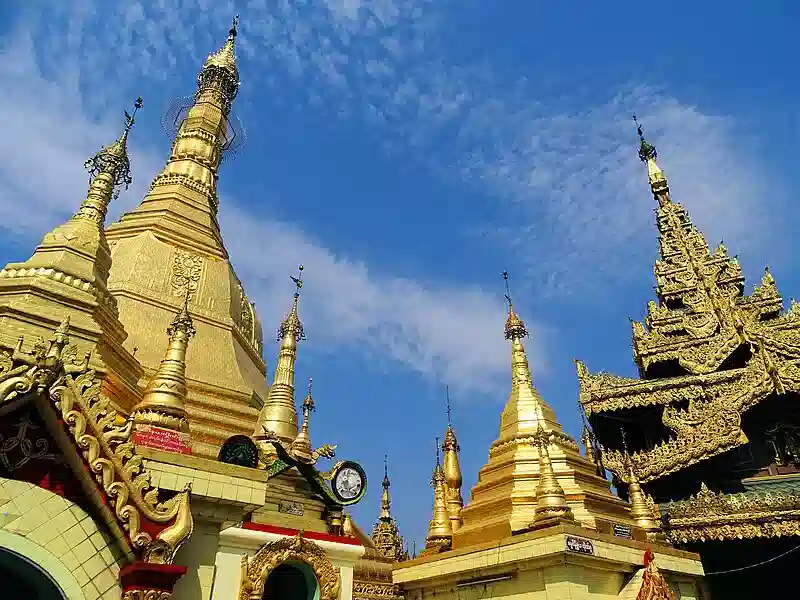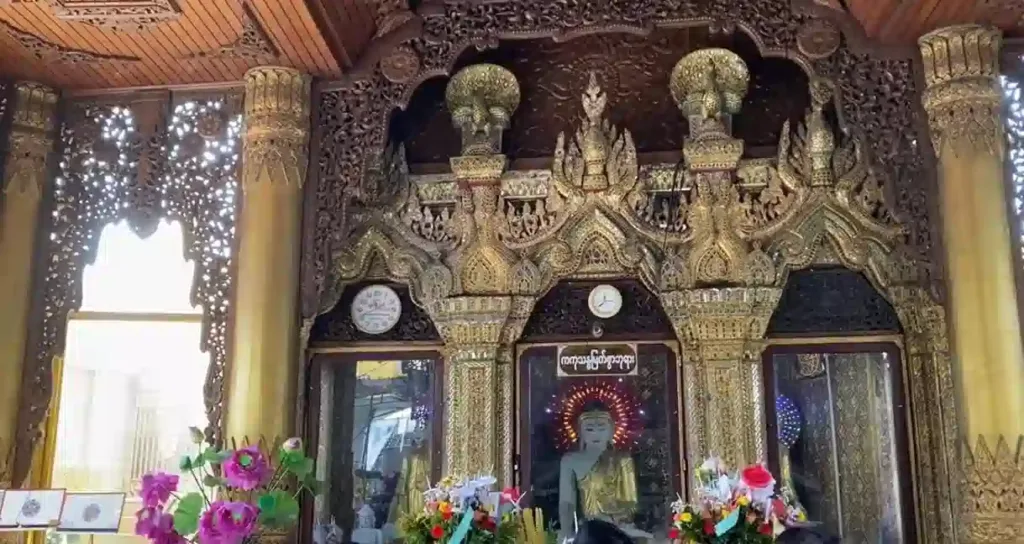Nestled in the heart of bustling Yangon, Myanmar, the Sule Pagoda stands as a timeless icon of both faith and heritage. Its golden spire rises above the city center, a glistening symbol of Buddhism and an architectural wonder with deep cultural roots.
Unlike other well-known pagodas in Myanmar, such as the Shwedagon Pagoda, Sule Pagoda is uniquely integrated into the daily life of Yangon, acting as both a religious center and a historical landmark.
As you discover the enchanting Sule Pagoda, you’ll uncover stories of resilience, faith, and beauty that reflect the spirit of Myanmar itself. This article will guide you through everything you need to know, from the rich history and architectural marvels of the pagoda to travel tips and nearby attractions, so you can fully experience the wonders of Sule Pagoda.

History of Sule Pagoda
The history of Sule Pagoda is deeply intertwined with Burmese culture and spirituality. According to local legends, it was constructed during the time of the Buddha and is said to enshrine a strand of his hair, gifted to two merchant brothers.
This makes Sule Pagoda one of the oldest pagodas in Myanmar, predating even the famous Shwedagon Pagoda.
The pagoda’s architectural style reflects a blend of Indian and Mon influences. Initially built in an Indian temple style, it underwent modifications during British colonial rule in the 19th century, adopting more distinctly Burmese elements.
The octagonal stupa stands at approximately 48 meters (about 144 feet) tall and is surrounded by smaller shrines and bronze bells, each contributing to its serene atmosphere.
During the colonial era, the British used the Sule Pagoda as a landmark to design the new grid pattern for the city, making it a central focal point in the urban planning of Yangon.
Today, it continues to be a prominent landmark and a point of reference for locals and visitors navigating the city.
Key Historical Events Shaping the Pagoda
Over centuries, Sule Pagoda witnessed the passage of various kingdoms and empires. During the Bagan, Toungoo, and Konbaung dynasties, it was restored and embellished, reflecting the changing styles and cultural influences of each era.
The pagoda’s resilience through wars and political upheaval further cements its role as a silent observer of Myanmar’s turbulent history.
Religious Importance and Symbolism
Sule Pagoda is a sacred site for Buddhists, embodying teachings of peace, enlightenment, and the pursuit of spiritual understanding. Pilgrims visit to meditate and offer prayers, seeking blessings for themselves and their loved ones.
The detailed architecture of Sule Pagoda, with its golden layers and sacred relics, represents key Buddhist symbols. The base octagon reflects the eightfold path in Buddhism, guiding believers on their spiritual journey toward enlightenment.
The Myths and Legends Surrounding Sule Pagoda
One of the most enduring legends surrounding Sule Pagoda is that of its guardian spirits, known locally as nats. These spirits are believed to protect the pagoda and its devotees, ensuring that peace and harmony prevail.
The story of the nat spirit named Sularnata, who guided King Okkalapa to build the pagoda, is still recounted with reverence.
The nat spirits play an integral role in Burmese folklore and are often venerated alongside the Buddha. Visitors can see small altars dedicated to these spirits, filled with offerings of flowers and fruits, a testament to the fusion of indigenous beliefs with Buddhist practices.
Transformations During the British Colonial Period
The colonial period brought significant changes to the landscape around Sule Pagoda. The British, who recognized its central location, designed Yangon’s street grid around it, emphasizing its importance as a landmark. Despite foreign rule, the pagoda remained a symbol of resistance and cultural pride for the Burmese people.
Post-Independence Restoration and Modern Changes
Post-independence, Sule Pagoda underwent extensive renovations to preserve its structure. It also became a focal point during significant national movements, including the 1988 pro-democracy protests and the 2007 Saffron Revolution, where monks led peaceful te monstrations against the military regime.

Architectural Marvel of Sule Pagoda
Sule Pagoda, an iconic symbol of Yangon, Myanmar, is not only a significant religious site but also a remarkable architectural feat. Its unique design, historical significance, and cultural relevance make it a must-visit for anyone exploring the city. Let’s a look at the architectural marvel of Sule Pagoda.
Unique Design and Structure
Sule Pagoda stands at an impressive height of 48 meters (157 feet). Its most distinctive feature is its octagonal shape, which is relatively rare among pagodas in Myanmar.
This octagonal design continues all the way to the spire, creating a striking silhouette against the Yangon skyline. The structure is adorned with a gold-plated dome and topped with a hti, a multi-tiered ornamental umbrella that is characteristic of Burmese pagodas.
Dimensions: Each side of the octagonal base measures approximately 24 feet.
Materials: The pagoda is constructed using traditional materials, with intricate carvings and embellishments that reflect both Indian and Mon architectural influences.
Symbolism in Architecture
The architecture of Sule Pagoda embodies key Buddhist symbols:
Octagonal Base: The octagonal shape represents the Eightfold Path in Buddhism, guiding followers on their spiritual journey.
Golden Layers: The gold plating symbolizes enlightenment and purity, essential themes in Buddhist teachings.
Bronze Bells: Surrounding the pagoda are ten bronze bells of varying sizes, each commemorating significant donations made for its upkeep.
Surrounding Structures
The pagoda complex includes several smaller shrines and structures that enhance its architectural landscape:
Buddha Statues: Eight Buddha statues surround the main stupa, each representing one of the days of the week (with two for Wednesday). Visitors often pray at these statues for blessings corresponding to their birth days.
Prayer Areas: Covered prayer areas provide spaces for devotees to meditate and offer prayers.
Nat Shrines: Small altars dedicated to local spirits (nats) can also be found within the complex, showcasing the blend of indigenous beliefs with Buddhism.
Visitor Experience
Visitors to Sule Pagoda are often struck by its serene atmosphere and stunning architecture:
Entry Requirements: Visitors must remove their shoes before entering, which is customary at Buddhist sites in Myanmar.
Lighting: The pagoda is particularly breathtaking at night when it glows under soft lighting, enhancing its majestic presence amidst the bustling city.
In summary, Sule Pagoda stands as an architectural marvel that encapsulates Myanmar’s rich history and spiritual depth. Its unique design, historical importance, and cultural significance make it not just a place of worship but also a symbol of resilience for the people of Yangon.
Cultural Celebrations and Events at the Pagoda
Throughout the year, Sule Pagoda hosts various religious festivals, including Thingyan (the Burmese New Year Water Festival) and Waso full moon ceremonies. These events attract thousands of devotees and tourists alike, showcasing the enduring spiritual and cultural vibrancy of the pagoda.

Visiting Tips
When visiting the Sule Pagoda, there are a few things to keep in mind. The pagoda is open from 4 AM to 10 PM, and there’s an entrance fee for foreigners.
Dress modestly, covering your shoulders and knees, and be prepared to remove your shoes and socks before entering the temple grounds. The northern entrance has an elevator, and the western entrance has an escalator, making it accessible for everyone.
The best time to visit is during the cooler months from November to February when the weather is pleasant. Early mornings or evenings offer a serene atmosphere for meditation and exploration.
Admission Fee: There is a nominal entrance fee ranging from $2 to $5 per person.
Guided Tours: opt for a guided tour to learn about the pagoda’s rich history and architectural details.
Photography: Capture stunning photographs of this iconic structure against the backdrop of bustling Yangon.
Cultural Immersion: Participate in local rituals or simply enjoy the peaceful ambiance that envelops this sacred site.
Nearby Attractions
Yangon is a city rich in history and culture, and there are plenty of other attractions to explore near the Sule Pagoda. Just a short distance away, you can visit the iconic Shwedagon Pagoda, the Bogyoke Aung San Market, and the Kandawgyi Lake. Each offers a unique glimpse into the vibrant life of Yangon.
♣♣You May Also Like: ⇓
- Wonderful Shwedagon Pagoda: Relics of the 4 Buddhas
- Wonderful Wat Huay Pla Kang In Chiang Rai, Thailand
- Tremendous Sukhothai, Thailand: A Rich Historic Hub
- Outstanding Yasaka Pagoda: A Timeless Landmark in Kyoto
- Bateshwar Dham, Agra: Hidden 101 Shiv Temples
Conclusion
Visiting the Sule Pagoda in Yangon is more than just a journey through an ancient landmark; it’s an immersion into the heart and soul of Myanmar.
As you walk through its sacred spaces, with the golden stupa glimmering in the sunlight and the quiet hum of prayer filling the air, you’ll feel a sense of connection to the layers of history and devotion that this pagoda represents.
Whether you’re seeking peace, curiosity, or inspiration, a visit to Sule Pagoda is a chance to witness the resilience, unity, and reverence that define Yangon and its people.
Embrace this timeless treasure and carry its spirit with you—a reminder that, in a fast-changing world, places like Sule Pagoda keep the past alive, providing a beacon of faith and reflection for generations to come.
FAQs:
1. What is the current travel advisory for Myanmar?
Many countries, including the U.S. and the U.K., advise against all travel to certain regions of Myanmar due to political unrest and violence. Check your government’s travel advisory before planning your trip.
2. What is Sule Pagoda?
Sule Pagoda is a historic Buddhist temple located in downtown Yangon, Myanmar. It is believed to be over 2,500 years old and enshrines a strand of the Buddha’s hair.
3. What are the visiting hours for Sule Pagoda?
Sule Pagoda is typically open daily from 4 AM to 10 PM. However, hours may vary during special events or festivals.
4. Can I take photographs inside Sule Pagoda?
Photography is generally allowed but be respectful and avoid taking pictures of people during prayers or ceremonies without permission.
5. How do I get to Sule Pagoda?
The pagoda is centrally located at the junction of Sule Pagoda Road and Mahabandoola Road, easily accessible by taxi or public transport.
6. Is Sule Pagoda wheelchair accessible?
Yes, the northern entrance has an elevator, and the western entrance features an escalator for easier access.
7. Are there shops near Sule Pagoda?
Yes, the area surrounding the pagoda has small shops offering services like astrology and palmistry as well as local handicrafts.
8. How long should I plan to stay at Sule Pagoda?
Visitors typically spend about 1-2 hours exploring the pagoda and its surroundings but can stay longer if participating in rituals or enjoying the atmosphere.
9. What makes Sule Pagoda unique compared to other pagodas in Myanmar?
Sule Pagoda’s octagonal shape and central location in Yangon make it unique among pagodas in Myanmar; it also serves as a significant cultural and political landmark in the city.
1 thought on “Great Sule Pagoda: the old Treasure of Yangon”